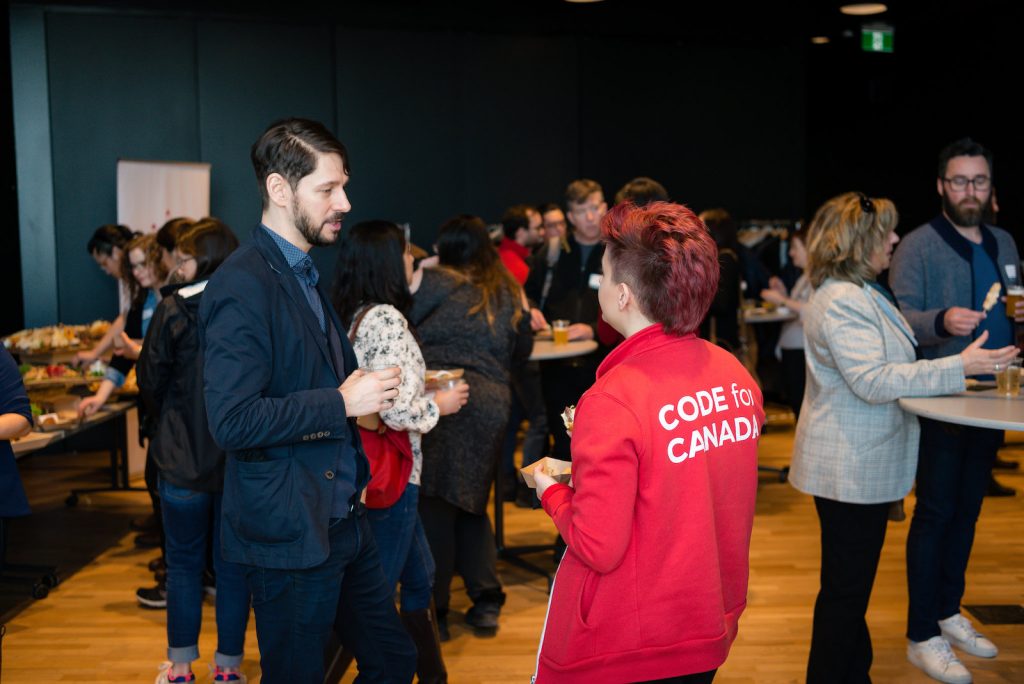The Say Yeah Team was especially excited to attend 2020’s Code For Canada Summit. Little did we know that this inaugural event would be our last large group gathering in awhile!
Thanks to the incredible Code for Canada staff and volunteers, this well-organized, diverse, and engaging event went off without a hitch. The location was a bonus, with the event held at the beautiful new Artscape Daniels Launchpad, which overlooks the Toronto waterfront.
Our video recap, part 1
We had the pleasure of speaking with some inspiring fellows and accomplished leaders throughout our two days at the conference. In our first recap video, we share highlights from our conversations with:
- Jaimie Boyd, Chief Digital Officer, Government of British Columbia
- Yael Berger, Senior Communications Advisor, Canadian Digital Service
- Safiah Chowdhury, Policy Development Officer, City of Toronto
- Jeff Maher, Principle Engineer, Canadian Digital Service
Transcript
Jaimie Boyd:
For me, when I think about the practices of highly proficient, digital governments, I put it into three big buckets. So, those buckets are being agile, being user-centric, and being open. So some of the things that have come out of the BC Government that I’m very proud of are commitments to user-centricity, and how we build digital services. So, one thing that we run is the BC Developer’s Exchange, or our Exchange Lab, it’s in Downtown Victoria, and it’s a phenomenal space, we have up to 12 teams from the ministries that are working in there at any time, and they show up with a clearly defined business problem, we mentor them, we support them through the physical space, and we use resources from the ministry to procure a technology team. That comes and is completely embedded with those public servants.
Yael Berger:
So one of those areas in government that is a bit new, and is a change or an area of change in government is the way that we do communications. And, so, like some of the new techniques and methods, and tools that are coming into government through digital transformation, it provides an opportunity to also push some of those edges for communications as well, and so, there’s been a chance and an opportunity to bring together folks in government who are trying to do new things in storytelling, and trying to use new ways of communicating with the public and with each other, yeah. And so, we’ve put together a community practice for storytelling the government. And there’s an opportunity to meet with people who work in different government departments that are doing this kind of work, and search a job from those practices.
Safiah Chowdhury:
For me, it’s always about speaking the language of the individual that you’re working with. So, in the upfront process, it’s a lot of what’s within your scope of possibility, and then we can kind of negotiate that together. So it’s not often that they’re invited to design charrettes, it’s more so about, okay I have this idea, for example, having a harm-reduction program from a culturally indigenous perspective. What does that look like for you, community health centre. What does that look like for you, indigenous serving organization, what does that look like for you, Toronto Public Health, and I can tell you what it looks like for me, from a social services point of view. And then, we collaborate and use, very often, traditional government tools like term sheets. And project plans, but truly the product is more collaborative than perhaps other government intervention.
Jeff Maher:
Yeah, there’s so many roadblocks, there’s the roadblock of trying to deliver things, in a short period of time, there’s roadblocks to being able to go out and do this research, and actually talk to the people that these benefits serve, there’s challenges in being able to use new tools and infrastructure. There’s tools around making things like consent forms plain language, while still pleasing the lawyers everywhere. Yeah, there’s just so many of them, and I think a big part of what we try to do, when trying to clear these roadblocks, is that we try to tell the story of why we’re doing it, and what the mission is, and there are many tools to do this, but being able to tell a story is one of the biggest tools to clearing those roadblocks.
Since 2017, Code for Canada has been our country’s most active civic tech nonprofit. They have a clear mandate: build digital capacity in government, and civic capacity in the tech and design community.
As part of our commitment to civic tech and improving government service design and product strategy capacity, Say Yeah CEO Lee Dale has acted as a Code for Canada Fellowship Selection Panelist since 2017.

These intersections are especially appealing to our team, and we greatly appreciate connecting with public sector techies, design professionals from all persuasions, and experts in inclusive design and community engagement.
In Part 2 of our Code for Canada Summit recap, we spoke with experts about inclusive design and collaboration in the public sector.
We’ve worked on a series of transformational public sector research, service design, and digital product projects over the years.
We’re here to help improve digital maturity, service delivery, and user experience, all through an inclusive lens.